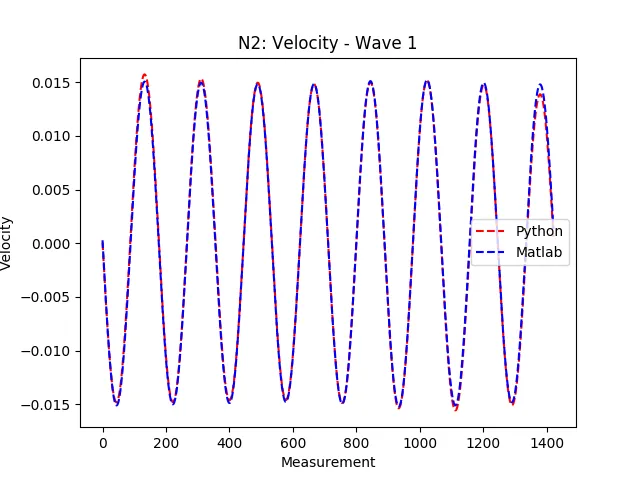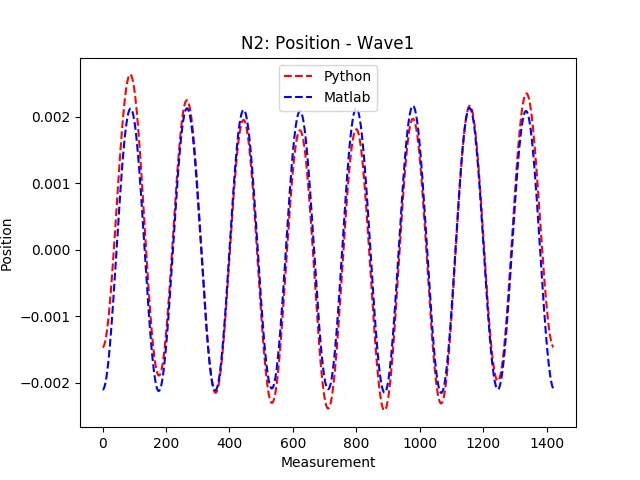我有一组包含加速度数据的时间序列,希望将其积分成速度和位移时间序列。这可以使用FFT完成,但是在Matlab和Python中使用两种方法得到了不同的结果。
Matlab代码:
这两个代码通常应该给出完全相同的结果,但是当我进行比较绘图时,得到了以下结果。
加速度转速度。 加速度到位置 有没有想法为什么Python的位置结果与Matlab结果不同?对于我来说,拥有相同的结果至关重要,因为我正在使用这些实验中的加速度测量来识别驳船的运动。
我还有第二个Python版本,其中我尝试包含Matlab代码中的滤波器。这也会给出不同的结果,就像Python中没有滤波器的结果一样。
这仍然与Matlab代码略有不同。有建议吗?
Matlab代码:
nsamples = length(acc(:,1));
domega = 2*pi/(dt*nsamples);
acchat = fft(acc);
% Make frequency array:
Omega = zeros(nsamples,1);
% Create Omega:
if even(nsamples)
nh = nsamples/2;
Omega(1:nh+1) = domega*(0:nh);
Omega(nh+2:nsamples) = domega*(-nh+1:-1);
else
nh = (nsamples-1)/2;
Omega(1:nh+1) = domega*(0:nh);
Omega(nh+2:nsamples) = domega*(-nh:-1);
end
% High-pass filter:
n_low=floor(2*pi*f_low/domega);
acchat(1:n_low)=0;
acchat(nsamples-n_low+1:nsamples)=0;
% Multiply by omega^2:
acchat(2:nsamples) = -acchat(2:nsamples) ./ Omega(2:nsamples).^2;
% Inverse Fourier transform:
pos = real(ifft(acchat));
% --- End of function ---
Python 代码:
import numpy as np
def acc2velpos(acc, dt):
n = len(acc)
freq = np.fft.fftfreq(n, d=dt)
omegas = 2 * np.pi * freq
omegas = omegas[1:]
# Fast Fourier Transform of Acceleration
accfft = np.array(np.fft.fft(acc, axis=0))
# Integrating the Fast Fourier Transform
velfft = -accfft[1:] / (omegas * 1j)
posfft = accfft[1:] / ((omegas * 1j) ** 2)
velfft = np.array([0] + list(velfft))
posfft = np.array([0] + list(posfft))
# Inverse Fast Fourier Transform back to time domain
vel = np.real(np.fft.ifft(velfft, axis=0))
pos = np.real(np.fft.ifft(posfft, axis=0))
return vel, pos
这两个代码通常应该给出完全相同的结果,但是当我进行比较绘图时,得到了以下结果。
加速度转速度。 加速度到位置 有没有想法为什么Python的位置结果与Matlab结果不同?对于我来说,拥有相同的结果至关重要,因为我正在使用这些实验中的加速度测量来识别驳船的运动。
我还有第二个Python版本,其中我尝试包含Matlab代码中的滤波器。这也会给出不同的结果,就像Python中没有滤波器的结果一样。
def acc2vel2(acc, dt, flow):
nsamples = len(acc)
domega = (2*np.pi) / (dt*nsamples)
acchat = np.fft.fft(acc)
# Make Freq. Array
Omega = np.zeros(nsamples)
# Create Omega:
if nsamples % 2 == 0:
nh = int(nsamples/2)
Omega[:nh] = domega * np.array(range(0, nh))
Omega[nh:] = domega * np.array(range(-nh-1, -1))
else:
nh = int((nsamples - 1)/2)
Omega[:nh] = domega * np.array(range(0, nh))
Omega[nh:] = domega * np.array(range(-nh-2, -1))
# High-pass filter
n_low = int(np.floor((2*np.pi*flow)/domega))
acchat[:n_low - 1] = 0
acchat[nsamples - n_low:] = 0
# Divide by omega
acchat[1:] = -acchat[1:] / Omega[1:]
# Inverse FFT
vel = np.imag(np.fft.ifft(acchat))
return vel
这仍然与Matlab代码略有不同。有建议吗?

